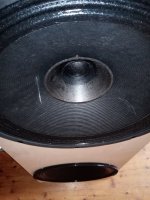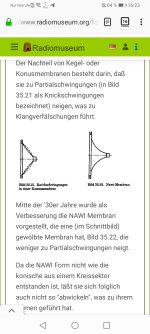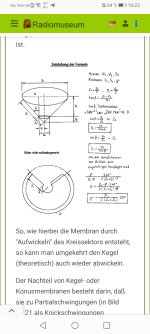Maybe one day I will scan the article.
But you can buy the article here
https://www.aes.org/e-lib/browse.cfm?elib=1505
Here with carbon
https://www.aes.org/e-lib/browse.cfm?elib=5236

Acrylic foam is used for the core and carbon fiber for the skin material of a loudspeaker diaphragm to achieve more rigidity, lower density, easier formability, and a higher Young's modulus. Unlike a honeycomb construction, this diaphragm material is relatively easy to form into a curved cone shape. The new diaphragm is at least 300 times more resistant to bending than a paper diaphragm, while nearly equal to paper in internal loss characteristics. The importance of diaphragm rigidity is confirmed by modal analysis and tone-burst tests.
Authors: Taguchi, Sadao; Watanabe, Toshio; Takahashi, Eiichi; Takahashi, Susumu; Tanaka, Susumu
Affiliation: Sansui Electric Company, Ltd., Tokyo 168, Japan
JAES Volume 34 Issue 11 pp. 895-904; November 1986
But you can buy the article here
https://www.aes.org/e-lib/browse.cfm?elib=1505
Here with carbon
https://www.aes.org/e-lib/browse.cfm?elib=5236
AES E-Library
Sandwich-Construction Loudspeaker Diaphragm with Foamed High-Polymer and Carbon Fiber

Acrylic foam is used for the core and carbon fiber for the skin material of a loudspeaker diaphragm to achieve more rigidity, lower density, easier formability, and a higher Young's modulus. Unlike a honeycomb construction, this diaphragm material is relatively easy to form into a curved cone shape. The new diaphragm is at least 300 times more resistant to bending than a paper diaphragm, while nearly equal to paper in internal loss characteristics. The importance of diaphragm rigidity is confirmed by modal analysis and tone-burst tests.
Authors: Taguchi, Sadao; Watanabe, Toshio; Takahashi, Eiichi; Takahashi, Susumu; Tanaka, Susumu
Affiliation: Sansui Electric Company, Ltd., Tokyo 168, Japan
JAES Volume 34 Issue 11 pp. 895-904; November 1986
Glue is important if you target CLD behavior. It is where most of the dampening happen ( by shear).
It depends of your goal/target: if you want to increase rigidity of membrane it might be a second factor, if you want to do this AND increase damping then it's not second anymore imo.
It's the dampening layer and it's interaction whith material used for sandwich which are the important point into a CLD approach.
It depends of your goal/target: if you want to increase rigidity of membrane it might be a second factor, if you want to do this AND increase damping then it's not second anymore imo.
It's the dampening layer and it's interaction whith material used for sandwich which are the important point into a CLD approach.
OK, both nitro cellulose and Pattex do some damping.
You can use the glue named in German Anlegemilch (nitro cellulose) as slight damping for paper cones. You see it on this the whizzer cone of this Fane Sovereign 15 300tc. And on the other Foto as a product from dukatshop.
I think that the aluminum does some damping. In my eyes it's the dominating factor.
It prevents from big resonance amplitudes.
The paper core itself has damping characteristics.
You can use the glue named in German Anlegemilch (nitro cellulose) as slight damping for paper cones. You see it on this the whizzer cone of this Fane Sovereign 15 300tc. And on the other Foto as a product from dukatshop.
I think that the aluminum does some damping. In my eyes it's the dominating factor.
It prevents from big resonance amplitudes.
The paper core itself has damping characteristics.
Attachments
What did you use to stick that on in this picture?The only thing: what is accessible to Diy people?
I do it with aluminium foil from the household with excellent sonic results.
View attachment 1204759
Eu sei o que é Rohacell.Rohacell é um núcleo de espuma mais recente
It's PattexWhat did you use to stick that on in this picture?
Maxine01, don't use direct translation within the forum it doesn't works great.
Copy/paste from your translator instead. 😉
Copy/paste from your translator instead. 😉
Can you give me a link or some names?There was also someone using tiny, thin walled glass spheres as a filler in a foam sandwich. Light and rigid were the virtues. Eton uses a carbon fiber hexagonal grid as the filler. Kind of like Aerolam.
Nawi is the most stable cone.I want to know how the speaker cone profile can affect the sound performance.
The speaker cone profiles I know of are:
Concave cone, widely used for Subwoofer, Woofer and Mid-Ranger.
Dome cone, often used for Tweeters and a few Mid-Rangers.
Flat cone, somewhat unknown, used for Woofers and Mid-Rangers.
But honeycomb structures are difficult to implement into this structure. Therefore often flat cones are used.
So nawi paper cone with sandwich aluminium foil is a good stiff structure.
https://www.radiomuseum.org/forum/technik_der_lautsprecher.html
Attachments
You could measure the speed of sound in the material combination that you chose. This determines the wavelength of a tone along that material, giving you the frequency when breakup could become a problem.
Kevlar carbon and foam make the most stable ones.Hello, I've read a lot about sandwich structures and some renowned companies have used them.
I'm currently working on a project of mine to make sandwich cones for my speakers.
The materials are:
Faces: Kevlar carbon fiber hybrid
Core: Low density expanded polystyrene (LDEP)
I want to know if there is another sandwich structure or better material than those I mentioned.
Currently I think the best sandwich structure for speaker cone.
However in listening tests I was quite happy with paper and aluminum. DSPed and so linearized it was good for fullrange drivers, too.
Harder cones are for classical multi way speakers good.
I didn't know this guy.Nawi is the most stable cone
It has a slight curvature, it reminds me of the Bowers and Wilkins Aerofoil.
My system will be 3-way stereo.Harder cones are for classical multi way speakers good.
In the past I was thinking about adding aluminum powder to the resin that I will use in the cone, but I was worried about the final weight of the structure, then give up the idea.
@Maxine01
Here you can get only high tech cone parts
https://speakerindustries.shop/de/spl/741035/10-membrans
If you ask repair shops for loudspeakers they can assemble a driver with your parameters.
Also northern Europe Flexunits company can do that but they use polyprop cones.
Here you can get only high tech cone parts
https://speakerindustries.shop/de/spl/741035/10-membrans
If you ask repair shops for loudspeakers they can assemble a driver with your parameters.
Also northern Europe Flexunits company can do that but they use polyprop cones.
Nawi is the Form of the coneI didn't know this guy.
It has a slight curvature, it reminds me of the Bowers and Wilkins Aerofoil.
Nawi is the most stable cone.
Which is only one parameter at play.
It might be very important or not, as always it'll depend of the final target designer seek to reach.
Maxine,
How do you plan to build your drivers? I mean, take an existing motor/ frame assembly and put your homemade membrane on it?
Here it's better explained
https://www.medienstimmen.de/exzerp...das-kennzeichen-des-guten-grosslautsprechers/
https://www.medienstimmen.de/exzerp...das-kennzeichen-des-guten-grosslautsprechers/
- Home
- Loudspeakers
- Multi-Way
- "W" Sandwich Structure Speaker Cone/Speaker Cone Profile



